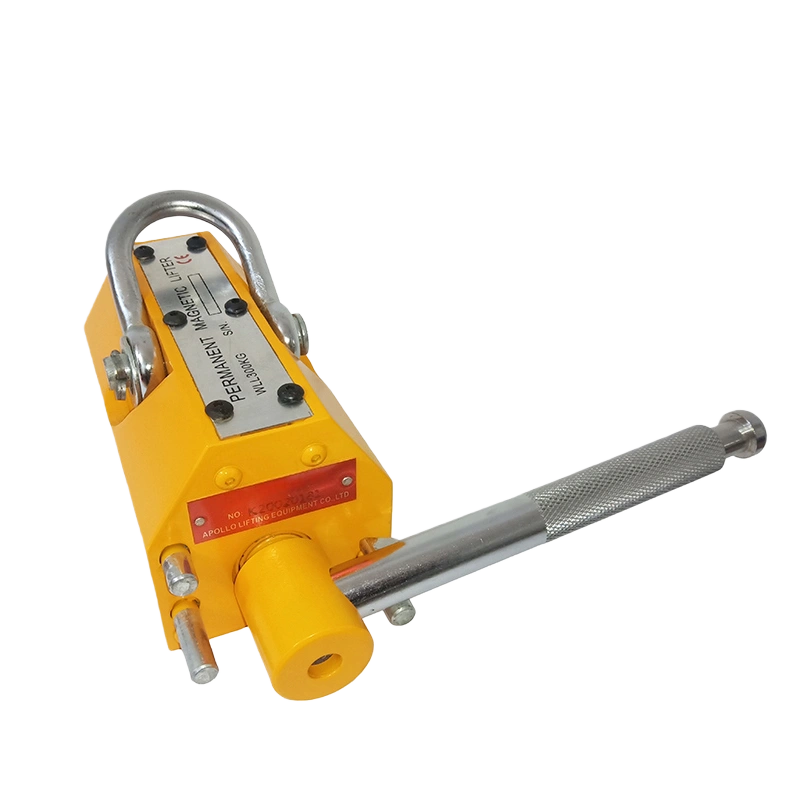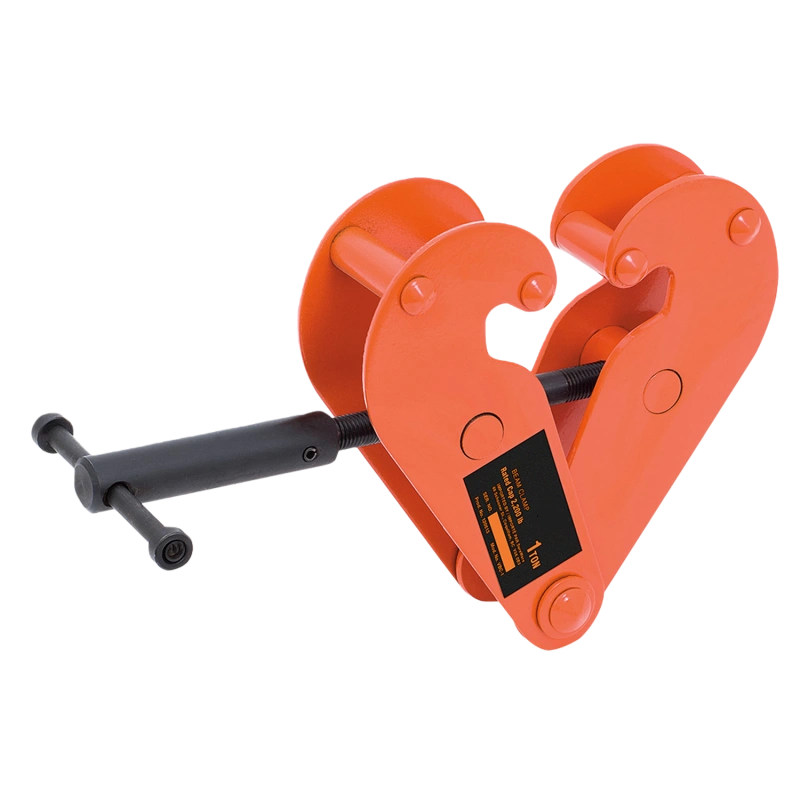PERMANENT LIFTING MAGNET DRAWING

PERMANENT LIFTING MAGNETS SPECIFICATIONS
| Fixed Power | Size | Pull off force(kg) | Net Weight(kg) | ||||||||
| Steel Plate(kg) | Round Steel(kg) | A(mm) | B(mm) | C(mm) | D(mm) | E(mm) | F(mm) | G(mm) | H(mm) | ||
| 100 | 50 | 95 | 85 | 77 | 80 | 140 | 155 | 30 | 68 | 350 | 3.5 |
| 300 | 150 | 180 | 175 | 86 | 85 | 130 | 185 | 53 | 52 | 1050 | 11.5 |
| 400 | 200 | 201 | 196 | 110 | 110 | 200 | 210 | 69 | 102 | 1400 | 18.2 |
| 600 | 300 | 221 | 217 | 115 | 125 | 217 | 235 | 69 | 102 | 2100 | 25 |
| 1000 | 500 | 295 | 291 | 142 | 140 | 270 | 265 | 82 | 140 | 3500 | 45 |
| 1500 | 750 | 313 | 352 | 145 | 152 | 280 | 350 | 100 | 134 | 5000 | 55 |
| 2000 | 1000 | 360 | 350 | 165 | 175 | 290 | 426 | 100 | 134 | 6000 | 80 |
| 3000 | 1500 | 460 | 450 | 180 | 186 | 300 | 520 | 100 | 134 | 9000 | 100 |
| 5000 | 2500 | 550 | 590 | 235 | 235 | 340 | 650 | 105 | 230 | 15000 | 240 |
| Steel Thickness | Ratio of Load Capacity PML | |||||||
| mm | inch | PML-30 | PML-20 | PML-10 | PML-6 | PML-4 | PML-1 | |
| T1 | Up60 | Up2.36 | 100% | 100% | 100% | 100% | 100% | 100% |
| T2 | 55 | 2.16″ | 95% | |||||
| T3 | 50 | 1.97″ | 90% | 95% | ||||
| T4 | 45 | 1.77″ | 85% | 90% | ||||
| T5 | 40 | 1.57″ | 80% | 85% | ||||
| T6 | 35 | 1.38″ | 70% | 75% | 90% | |||
| T7 | 30 | 1.18″ | 60% | 66% | 80% | |||
| T8 | 25 | 0.98″ | 50% | 55% | 70% | 90% | ||
| T9 | 20 | 0.79″ | 40% | 45% | 60% | 75% | 90% | |
| T10 | 15 | 0.59″ | 30% | 35% | 50% | 60% | 70% | |
| T11 | 10 | 0.39″ | 20% | 25% | 35% | 45% | 70% | |
| T12 | 5 | 0.20″ | 10% | 15% | 20% | 25% | 30% | 40% |
PERMANENT MAGNETIC LIFTER FEATURES
-
High-performance Nd-Fe-B permanent magnets
-
Zero electricity required for operation
-
Compact, lightweight, and easy to operate
-
Safety lever with 3.5x rated capacity pull-out force
-
Advanced magnetic circuit with strong suction and minimal residual magnetism
-
Ergonomic design with a safety button
-
No maintenance or operating costs
-
Durable construction with forged hook and precision assembly block
-
Ideal for industrial use in factories, docks, and warehouses
PERMANENT LIFT MAGNETS INSTRUCTIONS & CAUTIONS
Ensure Clean and Smooth Contact Surfaces
For optimal lifting, the magnet’s contact surface and the material being lifted must be clean and smooth. Dirt, rust, or any rough surfaces can cause air gaps, which reduce the magnet’s lifting power. Make sure both surfaces are flat for the best magnetic connection and lifting efficiency.
Correct Placement and Operation of the Magnet
Always place the permanent magnet lifter directly on a ferrous (magnetic) surface. Never use it on non-magnetic materials like wood, as the lever won’t work properly. To activate the magnet, pull the lever out, turn it to the “ON” position, and release it to lock it in place. When you’re done, switch it “OFF” by reversing the process.
Move Loads Smoothly and Safely
Move your load carefully, avoiding shocks or sudden movements. Impacting the load can weaken the magnetic grip and even cause it to detach. Always ensure the magnet is turned off when lowering the load or placing it down, and confirm the surface is stable.
Proper Maintenance and Storage
When not in use, protect the magnet lifter by applying grease or oil to the magnetic poles to prevent rust. Store the lifter on a thick wooden surface to avoid damaging the magnetic poles. This ensures the equipment stays in top condition and performs reliably when needed.
OUR ADVANTAGES
Tailored Solutions and Expert Support
We don’t just provide equipment—we offer solutions. Our team works closely with you to design custom-engineered solutions that fit your specific needs. Whether you're looking for technical advice or equipment optimization, our experienced professionals are ready to provide expert support, helping you boost efficiency and productivity with the right tools.
One-Stop Sourcing and Fast, Reliable Delivery
With Powerful Machinery, sourcing equipment has never been easier. We offer one-stop sourcing for all your lifting equipment needs, making it simple to place orders, track shipments, and get everything in one go. Our efficient logistics system ensures timely deliveries, minimizing your downtime and keeping your operations running smoothly.
Unmatched Quality and Safety Standards
At Powerful Machinery, we focus on delivering top-tier quality and safety. Every product undergoes rigorous quality checks to ensure it meets industry-leading standards. We use only the best materials and continuously test our products for performance, so you can rely on safe, durable equipment that gets the job done right, every time.
Dedicated After-Sales Service and Customer Care
Our relationship with you doesn’t end after the sale. Powerful Machinery is committed to offering exceptional after-sales service, from training to ongoing support. Our responsive customer care team is available to help with troubleshooting, spare parts, or any questions, ensuring your equipment keeps performing at its best.
FAQ OF PERMANENT MAGNET LIFTER
What is a magnetic lifter?
A magnetic lifter is a lifting tool that uses magnets to lift and move heavy metal objects like steel plates, blocks, and molds. Unlike traditional lifting equipment, magnetic lifters are powered by permanent magnets, so they don’t require electricity to operate. They’re ideal for industrial use, offering a simple, energy-efficient way to move heavy, ferrous materials safely.
How do lifting magnets work?
-
Magnetic Field Generation
Lifting magnets create a magnetic field that attaches to ferrous (magnetic) materials such as steel and iron. -
Permanent Magnetic Field
For permanent lifting magnets, the magnetic field is always active, meaning they don’t require an external power source to generate the force. -
Engagement
The magnet is placed directly onto a metal surface. A lever or switch is then used to activate the magnetic force, allowing the magnet to securely grip the object. -
Release of Load
Once the load is in position, the lever or switch is turned off, which safely deactivates the magnetic force and releases the object.
How do I inspect a lifting magnet?
-
Check the Magnetic Poles
Inspect the magnetic poles for any signs of rust, corrosion, or physical damage that could reduce lifting power. -
Examine the Lever Mechanism
Ensure the lever or switch mechanism operates smoothly. It should engage and release securely without any resistance or issues. -
Verify the Magnet’s Grip
Place the magnet on a clean, flat ferrous surface and check if it grips the material firmly. A secure grip ensures safe lifting and prevents accidents. -
Perform a Test Lift
Conduct a test lift with a known load to confirm the magnet’s lifting capacity and ensure the magnetic force is fully functional. -
Follow Manufacturer Guidelines
Always refer to the manufacturer’s inspection instructions for any additional checks or specific maintenance recommendations to keep the lifter in optimal condition.
How long does a permanent magnet last?
A permanent magnet lifter can last for years when properly maintained. With regular cleaning and care, the magnets retain their strength for a long time. Most lifters will operate reliably for over 10 years, especially if used in controlled conditions. However, environmental factors like moisture or extreme temperatures can affect longevity, so regular maintenance is key to maximizing lifespan.
What materials can permanent magnet lifters handle?
Permanent magnet lifters are designed to lift ferrous materials, such as steel, iron, and other magnetic metals. They work best for items like steel plates, beams, molds, and blocks. However, they cannot lift non-ferrous materials such as aluminum, copper, or wood, as these do not interact with the magnetic field.
Can a permanent magnet lifter be used for lifting thin materials?
Permanent magnet lifters work best on thicker materials that provide enough magnetic contact. When lifting thin materials, the reduced surface area means less magnetic force, which can lower the lifting capacity. Always check the minimum thickness required for the lifter to ensure effective operation.
What are the advantages of permanent magnets over electro lifting magnets?
-
No External Power Supply Needed
Permanent magnets are self-contained and do not require an external power source to generate magnetic force, making them more convenient and reliable. -
Simpler and Lighter
Permanent magnets are simpler in design and lighter in weight compared to electromagnetic lifters, which require complex electrical components. -
Cost-Effective
Because they don’t rely on an external power supply, permanent magnets are generally more cost-effective to operate and maintain than electromagnets. -
Energy-Efficient
Permanent magnets do not consume energy to maintain their magnetic field, making them more energy-efficient and reducing operational costs over time.
How do I choose the right lifting magnet for my needs?
-
Consider the Weight of the Material
Choose a lifting magnet with a lifting capacity that exceeds the weight of the material you’re handling. This ensures safe and efficient lifting. -
Assess the Size and Thickness
The size and thickness of the material are key factors. Ensure the magnet can handle the specific dimensions of the material you’re lifting for optimal performance. -
Check Material Compatibility
Make sure the lifting magnet is rated for the correct material type—permanent magnets work best with ferrous metals like steel and iron. -
Review Product Specifications
Always check the product specifications for lifting capacity, safety ratings, and other technical details to ensure it meets your specific lifting requirements.
What should I do if my lifting magnet stops working?
If your lifting magnet stops working, first check the lever mechanism to ensure it’s properly engaged. Inspect the magnet for signs of damage, rust, or wear, especially on the magnetic poles. If you still experience issues, consult the manufacturer’s troubleshooting guide or contact our support team for assistance with repairs or replacements.




